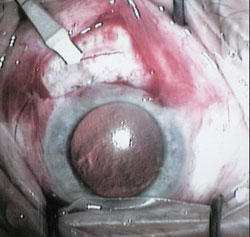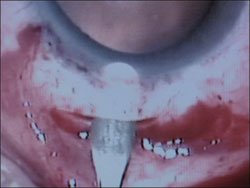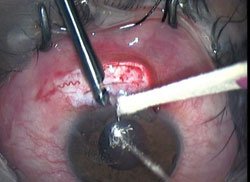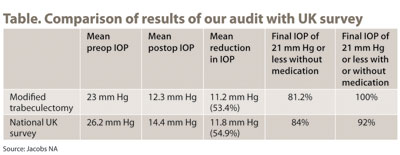Modified trabeculectomy technique called effective, quick, reproducible
The authors describe a punch technique with no iridectomy that has comparable results to standard trabeculectomy.
This is an update on a modified trabeculectomy technique that was first presented in Ocular Surgery News in 2005. In our first report, we described an audit of 28 eyes of 18 patients compared with a group of standard trabeculectomies.
In this report, we compare a group of 19 eyes of 18 patients against standard trabeculectomy as reported by the Royal College of Ophthalmologists National Trabeculectomy Audit.
Preoperatively, we select patients with a reasonable anterior chamber depth. If the patient has a plateau iris configuration, this is not a problem as long as the peripheral anterior chamber depth is moderate. In combined phacoemulsification-trabeculectomy cases, a shallow anterior chamber is acceptable. Any patients with iris damage — for example, if they have angle-closure glaucoma or have taken tamsulosin hydrochloride adrenergic alpha-1a receptor blocker — are excluded. Previous YAG iridotomy or peripheral iridectomy is not a problem. Pilocarpine is not used preoperatively because this tends to shallow the anterior chamber, and I have not found it to be helpful. Local anesthesia can be done with peribulbar or sub-Tenon’s administration.
It is important that the eye is relatively soft during surgery. A hard eye will lead to problems with the iris coming forward during the procedure, which could result in the need to convert to a standard trabeculectomy with an iridectomy. I recommend a maximum of 3 mL of local anesthetic.
I normally use a superior rectus retraction suture. If a corneal suture is preferred, then the 12 o’clock position should be avoided because this is where the tunnel is going to be made.
Surgical steps
A conjunctival fornix-based flap is formed, the surgical blue line is identified, and a mark 1.5 mm posterior and 1 mm anterior to the blue line is made. A guarded depth incision of 300 µm is made 1.5 mm behind the surgical blue line, around 3 mm in length (Figure 1).
The Sharpoint precision depth blade is preferred. The scleral tunnel is made using the 2.2-mm angled bevel-up crescent knife from Aspen Medical (Figure 2).
Once the true limbus is reached, it is prudent to angle the blade slightly upward to follow the contour when entering the cornea. This helps avoid the blade cutting deeper than desired. Once slightly past the 1 mm anterior point to the blue line, an anterior chamber entry is created with a keratome slit blade of around 2.75 mm. It is important to identify the surgical blue line because the vascular limbus is an unreliable indicator. In combined surgery, phaco and IOL placement are performed at this stage.
The anterior chamber is then filled with viscoelastic. Chondroitin sulfate, as in DuoVisc (chondroitin sulfate, sodium hyaluronate, Alcon), is preferred. The Jacobs punch is introduced into the scleral tunnel with the mouth open and positioned inferiorly. It enters the anterior chamber with a palpable click and is slightly withdrawn until the tip is engaged into the corneal tissue. The instrument is squeezed to activate the punch and is slowly withdrawn with the segment of tissue (Figure 3). It is important to carefully observe this process to ensure that no additional tissue, such as the iris, is accidentally included.
 Figure 1. Guarded depth incision. |
 Figure 2. Crescent knife scleral tunnel. Images: Jacobs NA |
 Figure 3. Jacobs punch with segment of tissue. |
 Figure 4. Viscoelastic ooze. |
Viscoelastic tips
Chondroitin maintains the anterior chamber depth and can safely be left in the anterior chamber at the conclusion of the procedure. Ordinary viscoelastic does not maintain the anterior chamber well enough, and a heavy alternative may lead to a high postoperative IOP. Once the punch is removed, it is usual to see viscoelastic slowly ooze from the wound (Figure 4). The conjunctiva is sutured in normal fashion.
If there is no ooze, the anterior chamber depth can be topped up with viscoelastic or a side incision at 90° can be performed. If there is still no ooze, a partial cut at one side of the scleral wound may enable the ooze. To convert to a normal trabeculectomy, cut one side fully, carrying out a peripheral iridectomy and then suturing the side back in place with a single Ethilon suture.
Healing modulation
The choice of anti-metabolite or other technique is left to the surgeon’s preference for trabeculectomy. If mitomycin C is used, it is important to carefully wash away any possible traces before entering the anterior chamber.
I feel that there will be a place for Avastin (bevacizumab, Genentech) combined with 5-fluorouracil in the near future. The Ologen collagen implant (Aeon Astron) also appears to be a useful product. I close the conjunctiva with interrupted 10-0 Vicryl sutures, which avoids the need for later removal. Follow-up includes the use of regular steroid drops for 2 months to 3 months. We do not use miotic or mydriatic agents. A 5-FU top-up can be used for the bleb at any time, and gonioscopy assessment may be helpful (Figure 5).
 Figure 5. Gonioscopy showing patent fistula. |
 Figure 6. Previous modified trabeculectomy showing functioning bleb after introducing Vision Blue during cataract surgery. |
 |
Our series consisted of six phaco-trabeculectomy combined procedures, two trabeculectomies on pseudo-phakic patients and 11 primary trabeculectomies.
Table confirms a similar success rate of both techniques with a final IOP control in each group, including those requiring treatment, as satisfactory. It also shows a high mean reduction in pressure from preoperative to postoperative levels in excess of 50% in each group.
Punches and iridectomy
The use of punches adapted to a scleral tunnel approach began with the Crozafon punch. Ferentini and Caccavale suggested that a scleral tunnel trabeculectomy had only an optional need for an iridectomy. Ahmed suggested that the peripheral iridectomy can be deferred in filtering surgery.
The Jacobs membrane punch offers advantages over the Crozafon-De Laage punch (Moria). It is one piece rather than three and, therefore, cannot be misassembled. Both punches remove a similar piece of membrane, and the Jacobs punch is a finer instrument with a tip shaped for easier tunnel insertion. It is obtainable as a reusable instrument from Duckworth & Kent and as a single-use instrument from SD Healthcare, both based in the U.K.
Conclusion
In conclusion, this is a trabeculectomy by numbers, which is effective (Figure 6), quick, reproducible, easily mastered and easily converted if necessary.
This technique can be used on nearly all patients who are being considered for a standard trabeculectomy. It works particularly well in combination with cataract surgery.
References:
- Edmunds B, Thompson JR, Salmon JF, Wormald RP. The National Survey of Trabeculectomy. II. Variations in operative technique and outcome. Eye (Lond). 2001;15(Pt 4):441-448.
- Ferentini F, Caccavale A. Scleral tunnel trabeculectomy. Ocular Surgery News. March 1997.
- Guttman C. Deferring PI in filtering surgery does not increase risks. Euro Times. 2002;7(12).
- Jacobs NA, Ghosh YK. Primary trabeculectomy without iridectomy easier with new membrane punch. Ocular Surgery News. May 15, 2005:3 (US Edition); April 2006:33 (Europe/Asia-Pacific Edition).
- N.A. Jacobs, FRCS, FRCOphth, can be reached at Birch Hill Hospital, Rochdale, UK; 44-20-8942-2960; fax: 44-20-8336-0779; email: nick.jacobs@btinternet.com.
- Disclosure: Dr. Jacobs has no direct financial interest in the products mentioned in this article. He is a paid consultant to Aspen Medical.

